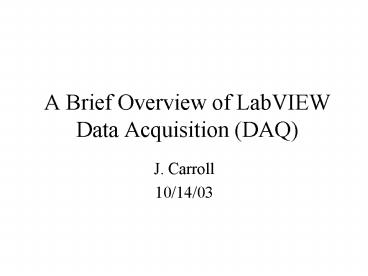A Brief Overview of LabVIEW Data Acquisition (DAQ) - PowerPoint PPT Presentation
1 / 12
Title:
A Brief Overview of LabVIEW Data Acquisition (DAQ)
Description:
Two characteristics help classify the type of DAQ operation performed. Whether you use a buffer ... Software triggering is the easiest and most intuitive ... – PowerPoint PPT presentation
Number of Views:55
Avg rating:3.0/5.0
Title: A Brief Overview of LabVIEW Data Acquisition (DAQ)
1
A Brief Overview of LabVIEW Data Acquisition (DAQ)
- J. Carroll
- 10/14/03
2
Overview of LabVIEW DAQ
- Two characteristics help classify the type of DAQ
operation performed - Whether you use a buffer
- Whether you use an external trigger to start,
stop, or synchronize an operation
3
Buffers
- A buffer is an area of PC memory reserved for
data, DMA allows data to be acquired directly
into computer memory - Not using a buffer means you must handle each
data point one at a time, as it is acquired - Use buffered I/O when
- Many samples are acquired at a rate faster than
is practical to display, store, or analyze in
real-time - Data is acquired/displayed continuously on the
fly - The sampling period must be precise and uniform
throughout the data samples
4
Buffers
- Use nonbuffered I/O when
- The data set is small and short (e.g., acquiring
one data point every 100ms) - Reduced memory overhead is required (since a
buffer takes up memory) - There are separate LabVIEW VIs for both buffered
and nonbuffered I/O
5
Triggering
- Triggering is any method which initiates,
terminates, or synchronizes a DAQ event - A trigger is usually an analog or digital signal
whose condition is analyzed to determine a course
of action - Software triggering is the easiest and most
intuitive - Hardware triggering lets the circuitry of the DAQ
board take control, adding more precision and
control
6
Triggering
- Use software triggering when
- The user needs to have explicit control over all
DAQ operations - The timing of an event does not need to be
precise - Use hardware triggering when
- Timing a DAQ event needs to be precise
- You want to reduce software overhead, i.e., to
reduce the need for a While Loop) - DAQ events need to be synchronized to external
events
7
Analog I/O Definitions
- A device is the number that NI-DAQ assigns to
an I/O board - A sample is one A/D conversion (one data point)
- Channels specify the physical source of the data
- A scan is a sample taken from each channel
- represents data versus channel number
- A waveform is a set of samples from one channel,
collected over a period of time - represents data versus time
8
The DAQ Palette
- The DAQ palette has three VI tiers
- Top tier VIs are easiest to use but least
flexible - these VIs are synchronous with the DAQ data,
meaning that they do not finish executing until
all of the data is read/written from the board - one fundamental limitation with these VIs is that
every time the VI is called the hardware is
setup for the sampling operating (adding
excessive overhead) - multiple sample points acquired using a While
Loop, which adds additional overhead - see class web site for more examples
9
Top Tier Examples
Nonbuffered, software triggered ADC
Buffered, hardware triggered ADC
10
The Middle/Bottom VI Tiers
- Middle tier VIs offer more functionality,
flexibility and efficiency - allows buffered acquisition that is hardware
controlled (see web for more examples) - allows continuous or real-time acquisition using
circular buffers - returns data from an acquisition in progress
without interrupting the acquisition - Bottom tier VIs offer the most functionality,
flexibility and efficiency, at the cost of
complexity (see web examples)
11
Middle Tier Example
Buffered DAQ
12
Example
Continuous, Circular Buffered DAQ































